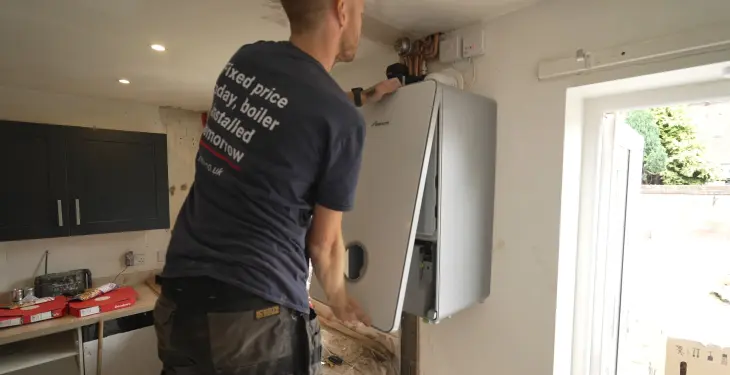

Written by Stephen Day
Gas Safe Engineer
Updated: 30th May, 2025
Understanding what the red light and associated fault codes mean is vital for boiler owners. It ensures that the appropriate steps can be taken to rectify the issue, whether that involves resetting the boiler, checking the pressure, or calling a Gas Safe registered engineer for a more complex problem.
Get a new boiler quote, save up to £550 per year (0% APR available).
A Vaillant boiler's red light is a clear indicator that the system has encountered an issue requiring attention. Vaillant boilers, renowned for their heating efficiency and reliability, utilise these indicators to signal to the user that there is a potential fault or operational problem.
These boilers are equipped with a series of error codes that can help diagnose the exact nature of the problem.
Understanding what the red light and its associated fault codes mean is vital for boiler owners. It ensures that the appropriate steps can be taken to rectify the issue, whether that involves resetting the boiler, checking the pressure, or calling a Gas Safe registered engineer for a more complex problem.
Regular qualified maintenance and boiler servicing are key to prevent such faults, and knowing the common issues can empower owners to act swiftly, maintaining the longevity and efficiency of a Vaillant boiler.
Get a quote in 60 seconds, fitted as fast as next day!
0% APR finance available.
When a red light appears on a Vaillant boiler, it signifies a fault that may require immediate attention. The guide below breaks down the meanings and common scenarios to help diagnose issues efficiently.
The red light on a Vaillant boiler is an indicator of a fault or lockout condition. It is often accompanied by an error code displayed on the boiler's control panel. The red light could point to various issues, including ignition problems, pressure discrepancies, or a need for an immediate service.
Types of Red Light Indicators:
Steady Red Light: Often indicates boiler lockout; no further operation until the fault is addressed.
Flashing Red Light: May signal specific fault conditions; reference the user manual for error code interpretation.
Pilot Light Issues:
If the red light is illuminated due to ignition failure, the pilot light may be out. Possible causes include a blocked jet that can be cleaned or replaced by a Gas Safe Engineer.
Pressure Problems:
Fluctuations in your boiler pressure, either too high or too low, can trigger the red light. It is crucial to check the pressure gauge and adjust as necessary.
Error Codes:
Vaillant boilers display specific error codes that correlate with the red light, such as:
F24: Highlighting a potential pump problem like a clog or failure.
Boiler Lockout:
A red light may indicate a boiler lockout, wherein the unit has shut down as a safety precaution. Factors causing this may include issues with the gas valve's position, ignition unit, or air intake vent.
Troubleshooting Steps:
Verify gas supply and pressure.
Check if the boiler error code is displayed and consult the manual for specifics.
Contact a Gas Safe registered engineer for an expert diagnosis and repair.
By understanding what a red light on a Vaillant boiler might mean and the common scenarios that can cause it, users can take informed steps towards troubleshooting or seek professional assistance to ensure the continuation of heating and hot water supply.
When a red light appears on a Vaillant boiler, it's often an alarm signalling a fault. Identifying and resolving the underlying issue is essential for restoring the boiler to operational status. The following are detailed steps to address the red light warning.
Firstly, attempt to reset the boiler. This process can resolve temporary glitches or errors. Consult the boiler's manual to locate the reset button or procedure, which typically involves holding a button for a specified duration.
Reset Button: Hold for 10 seconds
Boiler Display: Monitor for change in error code or light
Ensure there’s a consistent power supply to the boiler. Interruptions or fluctuations can trigger the red light. If the boiler is unresponsive or the display is off, check the fuse box for any tripped circuits.
Fuse Box: Look for tripped breakers, restore if necessary
Boiler Plug/Connection: Verify it is secure
The red light may indicate a failure to ignite, which could be due to a blocked ignition jet or a malfunctioning flame sensor. Inspect these components for cleanliness and integrity. If the ignition jet is blocked, it may be cleared with care; however, professional assistance is advised.
Ignition Jet: Check for blockages and clean carefully
Flame Sensor: Examine for damage or dirt
Finally, rule out issues with gas supply. A closed valve, low pressure, or supply interruption can prevent ignition, thus tripping the red light.
Gas Valve: Confirm it is open and functioning correctly
Supply Pressure: Assess for adequate pressure levels
It's important to approach these troubleshooting steps methodically, and seek a certified gas engineer's expertise if the problem persists or if there's uncertainty in conducting these checks safely.
Pressure issues in Vaillant boilers can manifest as a red light indicator, often pinpointing an anomaly in water pressure. Homeowners must distinguish the symptoms, understand the function of the filling loop and adopt measures to mitigate low water pressure.
A Vaillant boiler's pressure is measured via the pressure gauge on the front panel. Ideally, the gauge should read between 1 and 2 bars; readings below signify low pressure. Persistent low pressure could hint at leaks, while sudden drops might suggest a faulty pressure sensor.
To counteract low pressure, the filling loop, which is a silver flexible hose with end valves, is utilised to re-pressurise the system. Here's how it should be performed step by step:
Ensure the boiler is off and cool.
Locate the filling loop beneath the boiler.
Open both valves carefully to allow cold water to enter the system.
Monitor the pressure gauge, aiming to reach the 1 to 1.5-bar mark.
Securely close both valves once the desired pressure is achieved.
Note: Refer to the boiler's manual since procedures may vary slightly for different models.
Maintaining correct water pressure is essential for efficient boiler operation. Here are a few tips:
Regularly Check the Pressure Gauge: A monthly inspection helps to preempt issues.
Look for Leaks: Regularly inspect the pipework for signs of leaks, as these can lead to pressure drops.
Annual Service: Professional servicing can catch early signs of a deteriorating pressure system.
Preventive measures go a long way in ensuring the longevity and efficiency of your boiler's pressure system.
Vaillant boilers are equipped with a system that displays error codes to diagnose various issues. Understanding these codes is essential for troubleshooting.
The fault codes on Vaillant boilers serve as a diagnostic tool indicating specific problems. A code often comprises one or two letters followed by numbers. For example:
F28: This code suggests the boiler has failed to ignite. Causes could include issues with the gas supply or ignition leads.
F22: This code points to a low water pressure fault within the boiler, possibly due to leaks or a faulty pump.
F75: Indicates a pump water pressure fault, often linked to a pressure sensor or pump failure.
If a Vaillant boiler displays an error code, certain steps can be taken:
F22 Fault: The system likely requires repressurising to between 1.0 and 1.5 bar. Checking for leaks and ensuring that there are no airlocks within the system is also advised.
F28 Fault Code: Ensuring the gas supply is present and that ignition leads are properly connected can resolve this error. If the code persists, a professional engineer's assessment is necessary.
For codes like F75, which involves a potential pump failure or pressure sensor issue, consulting with a certified engineer is generally recommended, as these components require technical expertise.
Overheating, signalled by errors like F20, demands an immediate system check to prevent further damage. Causes can range from circulation issues to limescale buildup, and solutions may involve professional cleaning or part replacement.
Overall, while some boiler errors can be rectified following the user manual or simple resetting procedures, it is often advisable to enlist the support of a Gas Safe registered engineer for accurate diagnosis and repair. Regular maintenance checks can preemptively minimise the risk of developing Vaillant boiler problems.
Regular maintenance of a Vaillant boiler is essential in ensuring the unit operates efficiently and safely. Proactive servicing by certified professionals and adherence to recommended user steps can help in pre-empting the red light warnings which often signify issues.
A Gas Safe registered engineer is qualified to conduct an exhaustive inspection and perform necessary repairs on a Vaillant boiler. These specialists are equipped to:
Assess: The boiler's condition, identifying any potential issues before they escalate.
Clean: Components such as the burner, heat exchanger, and condensate trap to ensure optimal performance and prevent blockages.
Test: The system thoroughly to confirm all working parts, including the ignitor and gas valve, function as required.
Key Entities:
Gas Safe registered engineer
Heating engineer
Service
Regular servicing should be scheduled at least annually to maintain the warranty and longevity of the boiler.
Day-to-day maintenance can be undertaken by users to support the functions of a Vaillant boiler:
Check: The pressure gauge regularly and repressurise the system, if necessary, as detailed in the boiler's troubleshooting guide.
Observe: Any error messages and consult the manual for guidance; red lights often indicate specific faults.
Entities to Note:
User maintenance
Troubleshooting guide
Users should not attempt any repairs that require opening the boiler casing. This is strictly a job for a gas engineer because of the risks involved with gas appliances. Regular user-level attention complements a professional annual service, thus prolonging the life and efficiency of the heating system.
When a Vaillant boiler's red light is illuminated, it typically signifies a specific component fault. Below, common issues related to primary components such as the pump and sensor are discussed, alongside targeted solutions.
If a Vaillant boiler's red light indicates a pump failure, it is often attributed to obstructions or mechanical failure within the device. Wilo and Grundfos pumps are commonly used in these systems and might present the following symptoms:
Noise: A noisy pump might suggest internal damage, necessitating inspection or replacement.
Leakage: Leakages indicate seal wear, requiring prompt replacement to prevent further damage.
To resolve these issues, one should first isolate the boiler and electricity supply before attempting any repairs. Skilled technicians might clean a clogged pump or replace it if necessary.
Temperature sensors are integral for boiler operation, as they monitor the heat exchanger's output. Corrective measures for malfunctioning sensors include:
Error Codes: Refer to specific error codes (e.g., F22, F23, F24) to diagnose sensor issues.
Malfunction: A failed sensor may need replacing, ensuring the boiler accurately measures water temperature.
One should check the flow and return probes for signs of breakage or a short circuit and replace them if compromised.
Thermostat issues in a boiler system manifest as inaccurate temperature control. To remedy this:
Inaccuracies: Adjust the thermostat settings to ensure they reflect actual temperature needs.
Replacement: A faulty thermostat must be replaced by a compatible unit to maintain efficient boiler operation.
During the calibration process, the system's integrity and responsiveness are paramount, with tests conducted post-calibration to confirm that the correct temperatures are consistently achieved.
The condensate pipe is prone to freezing during the colder months, which can lead to boiler faults. Here's how to tackle a frozen condensate pipe:
Thawing: Applying warm, not boiling, water to the external part of the pipe can thaw it.
Insulation: Properly insulating the pipe can prevent freezing during subsequent cold spells.
Inspect the pipe for signs of damage or blockage that could impede the flow of condensed water from the heat exchanger, and take the necessary corrective action if needed.
Selecting the correct replacement boiler can significantly enhance heating efficiency and reduce energy costs. With advancements in technology, modern boilers offer substantial improvements over older systems.
When replacing an older boiler, carefully consider the type of boiler that best suits your needs. Two popular choices are the combi boiler and the condensing boiler.
Combi Boilers: These modern boilers provide heat and hot water from a single unit, making them a space-saving and efficient option for smaller homes.
Condensing Boilers: Known for their high efficiency, these boilers convert more gas into heating energy, contributing to lower energy bills and reduced carbon footprint.
Replacement components should ideally be from the same manufacturer to ensure compatibility. Ideal, Vaillant, and other reputable brands offer a range of boilers to replace aged or malfunctioning systems. When upgrading, assessing the size and heating requirements of your home is crucial to select a new boiler with the appropriate output.
Modern boilers integrate advanced technology that can greatly increase energy efficiency.
Smart Controls: These allow you to manage your heating remotely and make automatic adjustments for peak efficiency.
Improved Heat Exchangers: Quality heat exchangers in modern boilers maximise heat transfer and reduce waste.
For homeowners with older boilers, upgrading to a new system may entail initial costs, but the long-term energy savings and increase in property value are worth considering. Professional assessment is beneficial to determine the best option tailored to your specific circumstances.
Maintaining high efficiency in Vaillant boilers involves proactive measures to prevent issues such as sludge build-up, insufficient air supply, and system blockages that can impede performance.
To safeguard a Vaillant boiler from sludge and scale, one must understand their impact on efficiency. Sludge—composed of rust and debris—can clog the central heating pump and radiators. Scale, on the other hand, accumulates in heat exchangers, impairing heat transfer. To prevent these issues:
Install a magnetic filter to capture sludge before it infiltrates the system.
Utilise water softeners in areas with hard water to reduce scale formation.
Adequate air supply is paramount for the combustion process and overall safety of the boiler. The air pressure switch is a critical component that monitors airflow, ensuring the correct amount for efficient operation. To maintain proper air supply:
Ensure flues and air vents are clear of obstructions.
Regularly inspect the air pressure switch for functionality.
Regular flushing and cleaning of the heating system are vital to remove sludge and other residues that can decrease efficiency. A flushed system allows water to circulate freely, optimising heat distribution. Conduct these steps:
Engage a certified engineer to perform a system flush periodically.
Post-flushing, add inhibitor solutions to the system to prevent corrosion and future sludge build-up.
When addressing a Vaillant boiler's red light indication, it's crucial to approach the situation with an awareness of safety and legal protocols. The guidance involves stringent compliance with gas safety regulations and the expertise of accredited professionals.
In the UK, safety regulations govern the installation, maintenance, and repair of gas appliances. Legally, all such work must adhere to the Gas Safety (Installation and Use) Regulations 1998. These regulations are in place to prevent accidents related to gas work, which can be hazardous if not carried out correctly.
Non-compliance not only poses significant risks but can also lead to legal action being taken against the responsible parties, including homeowners, landlords, and the engineers themselves.
Only Gas Safe registered engineers are legally permitted to work on gas appliances, including addressing issues such as a red light on a Vaillant boiler. Choosing a Gas Safe engineer ensures that:
The individual has the proper qualifications and up-to-date knowledge to safely deal with gas appliances.
They adhere to the current industry standards and legal requirements, minimising safety risks to occupants.
To verify a Gas Safe engineer, you can request to see their Gas Safe ID card. The back of the card details the types of appliances they are qualified to work on, ensuring they are suitable for your specific boiler needs.
New boilers can be a daunting purchase for many people as they’re an appliance with a lot of responsibility, providing heat for you and your family is something you want to get right. Boilers aren’t exactly a quickly disposable item either, potentially lasting you a decade.
Effectively, new boiler cost can be split into two segments: the first is the actual boiler itself (unit price), and the second is the cost of the boiler being installed (set up) in your property by an expert engineer.
Here at iHeat, we want to remove all of this undue stress and make the decision making process of upgrading to a new central heating system, as easy as possible.
Boiler costs can vary depending on a number of factors including their brand, model, fuel, output, warranty, labour and boiler installation type. Typically a new boiler will cost between £1,845 and £3,500, below is a list of average boiler installations offered by iHeat (guide only).
Installation Type | Price (inc VAT) | |
Combi to combi swap | £1,845 | |
System to combi conversion | £2,499 | |
New boiler install | £2,899 | |
Back boiler to a combi | £3,299 | |
System to system | £1,945 |
Last updated: 30th May, 2025

Written by Stephen Day
Gas Safe Engineer at iHeat
Stephen Day is a Gas Safe registered and FGAS certified engineer with over 20 years of hands-on experience in the heating, cooling, and renewable energy industry, specialising in boiler installations, air conditioning, and heat pump systems.
LinkedInArticles by Stephen Day are reviewed by iHeat’s technical team to ensure accuracy and reliability.

22nd December, 2025
Based on data from over 7000 boiler installations completed by iHeat in the past 12 months...
 Read Article
Read Article

22nd December, 2025
Here’s a quick roundup of the best combi boilers for 2026.
 Read Article
Read Article

22nd December, 2025
When your old boiler breaks down and it comes time to replace it with a new one, it might...
 Read Article
Read Article
No obligation. Takes less than 60 seconds.